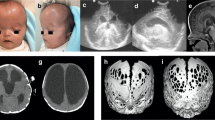Abstract
Chiari III malformation is considered to be a rare congenital abnormality in human with very high mortality rates. Seventy percent of Chiari III is found to be associated with C1 arch defect as reported by Cakirer (Clin Imaging 27:1–4, 2003). The herniation of posterior fossa elements or dysplastic neural tissue is a must to stamp it as Chiari 3 malformation. The malformation is a result of the abnormal development of craniovertebral junction (CVJ). The CVJ developed from the occipital somites and the first spinal sclerotome. The major role in the development of the CVJ is played by the fourth occipital somite, which is otherwise known as “proatlas.” The Chiari III anomalies are due to a result of proatlas defect, which results from failures of segmentation, failures of fusion of different components of each bone, or hypoplasia and ankylosis. We are presenting a case of a 1-year 4-month-old female child who presented with pedunculated swelling at the suboccipital region. The swelling was cystic and with pulsation. On evaluation, we found Chiari III anomaly with C1 posterior arch deficiency (proatlas defect). He was surgically managed. The outcome of the patient was good. Despite literature concluding Chiari 3 malformation with an unfavorable outcome, however, meticulous management and good pre- and postoperative care, physical therapy, and follow-up are necessary for good outcome.




Similar content being viewed by others
References
Koehler PJ (1991) Chiari’s description of cerebellar ectopy (1891). With a summary of Cleland’s and Arnold’s contributions and some early observations on neural-tube defects. J Neurosurg 75:823-826
Iskandar BJ, Hedlund GL, Grabb PA, Oakes WJ (1998) The resolution of syringohydromyelia without hindbrain herniation after posterior fossa decompression. J Neurosurg 89(2):212–216
Kim IK, Wang KC, Kim IO, Cho BK (2010) Chiari 1.5 malformation: an advanced form of Chiari I malformation. J Korean Neurosurg Soc 48(4):375–9
Arnautovic A, Splavski B, Boop FA, Arnautovic KI (2015) Pediatric and adult Chiari malformation type I surgical series 1965–2013: a review of demographics, operative treatment, and outcomes. J Neurosurg Pediatr 15(2):161–77. [PubMed]
Langridge B, Phillips E, Choi D (2017) Chiari malformation type 1: a systematic review of natural history and conservative management. World Neurosurg 104:213–219. [PubMed]
Cakirer S (2003) Chiari III malformation: varieties of MRI appearances in two patients. Clin Imaging 27:1–4
Jeong DH, Kim CH, Kim MO, Chung H, Kim TH, Jung HY (2014) Arnold-Chiari malformation type III with meningoencephalocele: a case report. Ann Rehabil Med 38:401–404
Arnold H (2008) Menezes embryology, development, and classification of disorders of the craniovertebral junction. https://doi.org/10.1055/b-0034-84432
Maroun FB (1998) Syringomyelia and the Chiari malformations 1997. Edited by John A. Anson, Edward C. Benzel, Issam A. Awad. Published by The American Association of Neurological Surgeons. 193 pages. $C124.00 approx. Can J Neurol Sci 25:175–5. [Google Scholar]
McLone DG, Knepper PA (1989) The cause of Chiari II malformation: a unified theory. Pediatr Neurosci 15:1–12
Lee R, Tai KS, Cheng PW, Lui WM, Chan FL (2002) Chiari III malformation: antenatal MRI diagnosis. Clin Radiol 57:759–761
Kanwaljeet Garg, Tandon V, Mahapatra AK (2011) Chiari III malformation with proatlas abnormality. Pediatr Neurosurg 47(4):295–8
Cama A, Tortori-Donati P, Piatelli GL, Fondelli MP, Andreussi L (1995) Chiari complex in children—neuroradiological diagnosis, neurosurgical treatment and proposal of a new classification (312 cases). Eur J Pediatr Surg 5(S1):35–8
Işik N, Elmaci I, Silav G, Çelik M, Kalelioğlu M (2009) Chiari malformation type III and results of surgery: a clinical study. PNE 45:19–28
Jaggi RS, Premsagar IC (2007) Chiari malformation type III treated with primary closure. Pediatr Neurosurg 43:424–427
Acknowledgements
We acknowledge SOA University (IMS and SUM Hospital), Bhubaneswar, Odisha, for allowing me in doing this work.
Author information
Authors and Affiliations
Contributions
All authors contributed to the study conception and design. Abhijt Acharya: conceptualization and first draft; Ashok Ku Mahapatra: editing and second draft; Souvagya Panigrahi: editing and manuscript writing; Rama Chandra Deo: editing; Satya Bhusan Senapati: prepare figures; Rajiba Lochan Samal: figure editing. All authors read and approved the final manuscript.
Corresponding author
Ethics declarations
Consent for publication
All authors have read and agreed for consent to send for publication.
Conflict of interest
None.
Additional information
Publisher's Note
Springer Nature remains neutral with regard to jurisdictional claims in published maps and institutional affiliations.
Rights and permissions
Springer Nature or its licensor (e.g. a society or other partner) holds exclusive rights to this article under a publishing agreement with the author(s) or other rightsholder(s); author self-archiving of the accepted manuscript version of this article is solely governed by the terms of such publishing agreement and applicable law.
About this article
Cite this article
Acharya, A., Panigrahi, S., Deo, R.C. et al. Pedunculated Chiari 3 malformation with proatlas defect. Childs Nerv Syst 39, 3613–3616 (2023). https://doi.org/10.1007/s00381-023-06044-6
Received:
Accepted:
Published:
Issue Date:
DOI: https://doi.org/10.1007/s00381-023-06044-6




